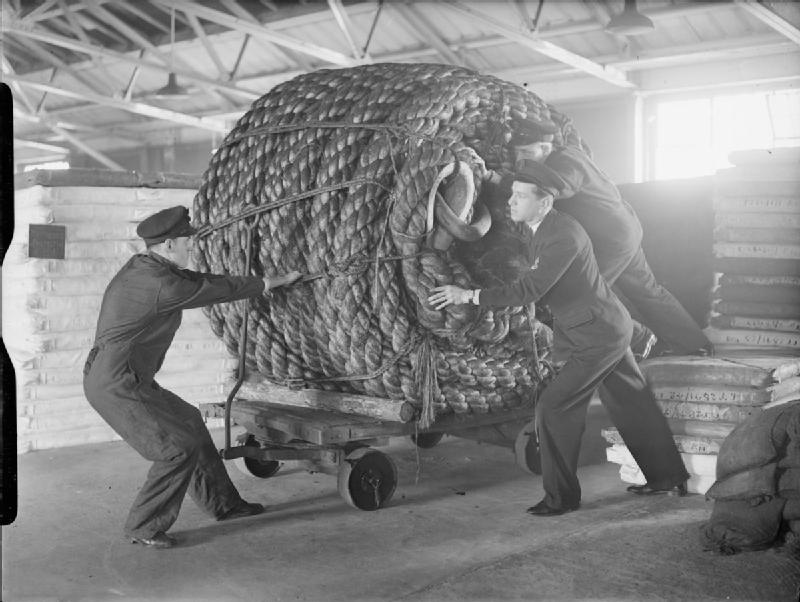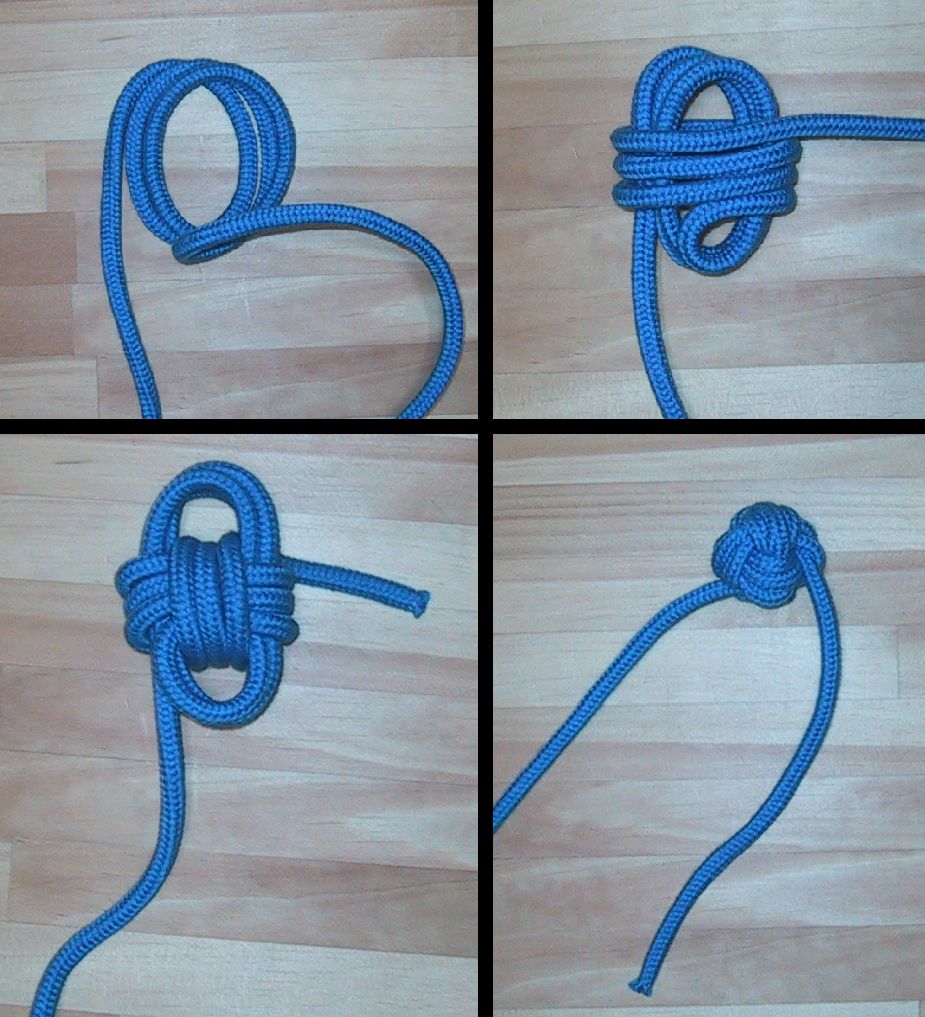|
Heaving Line Knot
A heaving line knot is a family of knots which are used for adding weight to the end of a rope, to make the rope easier to throw. In nautical use, a heaving line knot is often tied to the end of a messenger line, which is then used for pulling a larger rope, such as a hawser. There are several distinct knots which all share the common name, ''heaving line knot''. The monkey fist is a well-known heaving line knot. Tying Heaving line knot Tying Stopper knot Make a Bight (knot), bight in the tail end of the rope. Wrap the working end around the tail toward the bight end, with multiple turns. Complete the knot by passing the tail end through the bight loop. File:Heaving line knot step1.jpg, Make a bight File:Heaving line knot step2.jpg, Wrap the working end around File:Heaving line knot step3.jpg, Put the end through the bight File:Heaving line knot step4.jpg, Tighten by pulling on the standing part to close the bight Similar knots File:FranziskanerKnoten O&Z.JPG, ABO ... [...More Info...] [...Related Items...] OR: [Wikipedia] [Google] [Baidu] |
Stevedore Knot
The stevedore knot is a stopper knot, often tied near the end of a rope. It is more bulky and less prone to jamming than the closely related figure-eight knot. Naming There is a lack of consensus among knot experts regarding the origin of the name. Many sources, including ''The Ashley Book of Knots'', suggest the knot was used by stevedores in their work loading and unloading ships. To raise and lower cargo they used large blocks and these required a larger stopper knot to prevent the line from running completely through the block. However, in ''The Art of Knotting & Splicing'', Cyrus Day disagrees, stating "the name originated in a pamphlet issued about 1890 by the C.W. Hunt Company, which sold rope under the name 'Stevedore'. It was subsequently adopted by dictionaries, engineers' handbooks, and other works of reference, and it is now firmly established in books, if not in the vocabulary of seamen."Cyrus Lawrence Day, ''The Art of Knotting and Splicing, 4th ed.'' (Anna ... [...More Info...] [...Related Items...] OR: [Wikipedia] [Google] [Baidu] |
Double Overhand Knot
The double overhand knot or barrel knot is simply an extension of the regular overhand knot, made with one additional pass. The result is slightly larger and more difficult to untie. It forms the first part of the surgeon's knot and both sides of a double fisherman's knot. According to ''The Ashley Book of Knots'', "A double overhand knot tied in a cat-o'-nine-tails is termed a blood knot." When weighted, it can be difficult to untie, especially when wet. The strangle knot is a rearranged double overhand knot made around an object. It is sometimes used to secure items to posts. Instructions for tying # Tie an overhand knot at the end of a rope but do not tighten the knot down. # Pass the end of the line through the loop created by the first overhand knot. # Tighten the knot down while sliding it into place at the end of the line. Be sure to leave some tail sticking out from the end of the knot. Alternatively, the working end of the rope can be wrapped around the standing ... [...More Info...] [...Related Items...] OR: [Wikipedia] [Google] [Baidu] |
Hawser
Hawser () is a nautical term for a thick cable or rope used in mooring or towing a ship. A hawser passes through a hawsehole, also known as a cat hole, located on the hawse.The American Heritage Dictionary of the English Language, third edition, Houghton Mifflin The asterisk ( ), from Late Latin , from Ancient Greek , ''asteriskos'', "little star", is a typographical symbol. It is so called because it resembles a conventional image of a heraldic star. Computer scientists and mathematicians often voc ... Company, pp. 829–30, References External links * {{Authority control Shipbuilding Sailboat components Sailing ship components Nautical terminology ... [...More Info...] [...Related Items...] OR: [Wikipedia] [Google] [Baidu] |
Monkey Fist
A monkey's fist or monkey paw is a type of knot, so named because it looks somewhat like a small bunched fist or paw. It is tied at the end of a rope to serve as a weight, making it easier to throw, and also as an ornamental knot. This type of weighted rope can be used as a hand-to-hand weapon, called a slungshot by sailors. It was also used in the past as an anchor in rock climbing, by stuffing it into a crack. It is still sometimes used today in sandstone, as in the Elbe Sandstone Mountains in Germany. Description The monkey's fist knot is most often used as the weight in a heaving line. The line would have the monkey's fist on one end, an eye splice or bowline on the other, with about 30 feet (~10 metres) of line between. A lightweight feeder line would be tied to the bowline, then the weighted heaving line could be hurled between ship and dock. The other end of the lightweight line would be attached to a heavier-weight line, allowing it to be drawn to the target easily. ... [...More Info...] [...Related Items...] OR: [Wikipedia] [Google] [Baidu] |
Bight (knot)
In knot tying, a bight is a curved section or slack part between the two ends of a rope, string, or yarn.. "Any slack part of a rope between the two ends, particularly when curved or looped." A knot that can be tied using only the bight of a rope, without access to the ends, is described as in the bight. The term "bight" is also used in a more specific way when describing Turk's head knots, indicating how many repetitions of braiding are made in the circuit of a given knot. Bight vs. open loop Sources differ on whether an open loop or U-shaped curve in a rope qualifies as a bight. treats bights and loops as distinct, stating that a curve "no narrower than a semicircle" is a bight, while an open loop is a curve "narrower than a bight but with separated ends". However, ''The Illustrated Encyclopedia of Knots'' (2002) states: "Any section of line that is bent into a U-shape is a bight." Slipped knot In order to make a slipped knot (also slipped loop and quick release knot), ... [...More Info...] [...Related Items...] OR: [Wikipedia] [Google] [Baidu] |
Hangman's Knot
The hangman's knot or hangman's noose (also known as a collar during the Elizabethan era) is a knot most often associated with its use in hanging a person. For a hanging, the knot of the rope is typically placed under or just behind the left ear, although the most effective position is just ahead of the ear, beneath the angle of the left lower jaw. The pull on the knot at the end of the drop levers the jaw and head violently up and to the right, which combines with the jerk of the rope becoming taut to wrench the upper neck vertebrae apart. This produces very rapid death, whereas the traditional position beneath the ear was intended to result in the mass of the knot crushing closed (occluding) neck arteries, causing cessation of brain circulation. The knot is non-jamming but tends to resist attempts to loosen it. Number of coils Surviving nooses in the United Kingdom show simple slipknots that were superseded in the late 19th century with a metal eye spliced into one end of ... [...More Info...] [...Related Items...] OR: [Wikipedia] [Google] [Baidu] |
List Of Knots
This list of knots includes many alternative names for common knots and lashings. Knot names have evolved over time, and there are many conflicting or confusing naming issues. The overhand knot, for example, is also known as the thumb knot. The figure-eight knot is also known as the Savoy knot or the Flemish knot. A * Adjustable Bend – can be easily lengthened or shortened * Adjustable Grip Hitch – a simple hitch which may easily be shifted up and down the rope while slack *Albright Special – used to tie two different diameters of line together, for instance to tie monofilament to braid *Alpine Butterfly (also known as Butterfly Loop) – a static loop mostly used by mountain climbers and rappellers for securing a carabiner to static rope. * Alternate Ring Hitching – covering a ring in hitching can prevent damage * Anchor Bend – attaching a rope to a ring or similar termination *Angler's Loop – knot which forms a fixed loop. Useful for fine or slippery line, it is ... [...More Info...] [...Related Items...] OR: [Wikipedia] [Google] [Baidu] |

